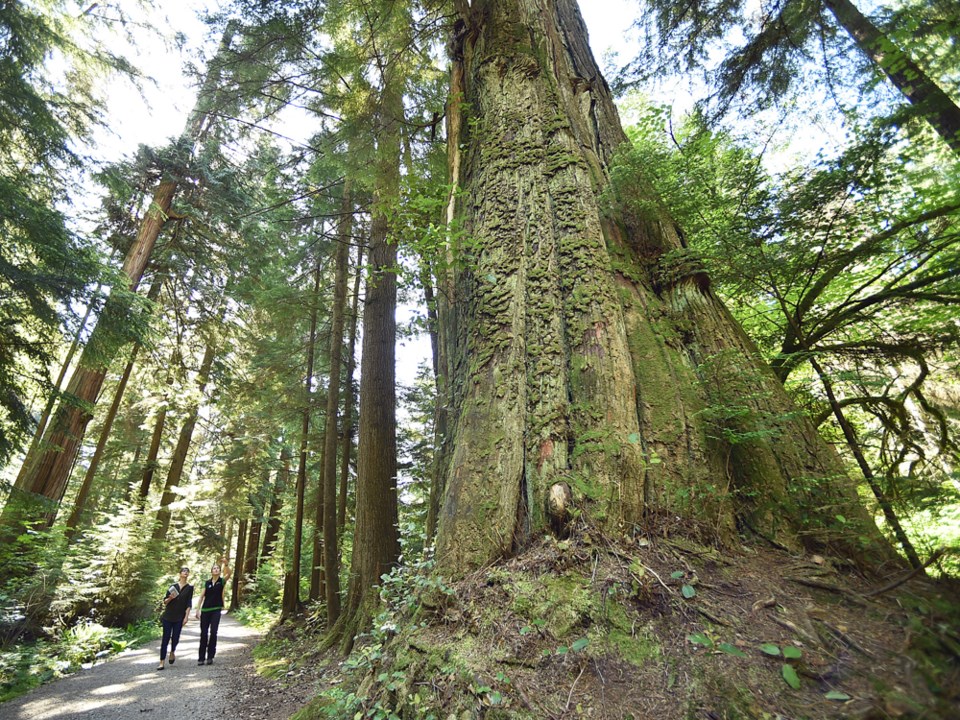Went for a walk the other day in a beautiful park to clear my head from this wacky election season and emerged from the woods feeling pleasantly impaired from the experience.
Didn't take much work, just put one foot in front of the other and enjoyed the forest, the sounds and the smells. It helped, of course, not being strafed by a crow or an owl, or getting some face time with mama bear.
I share this anecdote knowing it's the time of year when more people come out of hibernation to enjoy the green space in their neighbourhoods and cities.
Some of you, undoubtedly, will visit Stanley Park.
Consider this question next time you're there: What if Stanley Park was simply an extension of the downtown peninsula and occupied by a forest of expensive highrises?
Ugh, right.
Don't worry, that's not going to happen. But what has happened in the Metro Â鶹´«Ã½Ó³»region between 2009 and 2014 is that more than 1,600 hectares of old and mature forests, wetlands, riparian areas and other "sensitive and modified eco-systems" were lost.
I put quotes around the last part of the sentence because I lifted the information from a report going before the Metro Â鶹´«Ã½Ó³»regional parks committee June 13.
Before I get to the report, take a guess what the loss of 1,600 hectares over a five-year period represents when compared to a football field, or some other immediately identifiable large space?
Answer: The equivalent of four Stanley Parks every five years.
Quite incredible, but not surprising when you consider the conversion of natural areas for residential, industrial, agricultural and commercial uses in the region over the past two decades.
The loss of green space is not new, as the Metro report points out in selling the need to devise a strategy to acquire more parkland and expand existing parks in the region.
Loss and degradation has occurred since the late 1800s. More people equals more housing equals more infrastructure equals the need for more everything to cater to a growing population.
The regional district identified this concern way back in 1967 when the region experienced a significant population growth. It devised a strategy to protect green space, and two years later, the first six regional parks opened to the public in 1969.
The population was roughly one million people.
Since then, the system has grown to a network of 22 regional parks, five greenways, two ecological conservancy areas and three regional park reserves.
The region's population is now 2.5 million people and expected to reach 3.7 million by 2050. That growth and pressure is not good news for nature or humans, as the following quote from the report outlines:
"Visitation to regional parks continues to grow twice as fast as population growth, but growth of the system is challenging in an increasingly competitive and expensive land market."
And there's this:
"Ten per cent of the region [approximately 30,000 hectares] consists of sensitive eco-systems that are still 'unprotected,' some of which could be acquired for regional parks; however, that land is disappearing."
With that comes a depressing conclusion—that the insane cost of land and its continued development throughout the region is also affecting the protection of nature.
I guess it's our own fault, or someone else's fault, or possibly all those politicians, economists, developers and other evangelists who continue to tell us that growth is good.
Good for whom?
That's an argument for another day, or David Suzuki.
Meanwhile, the district has what it calls a bold plan to expand parkland and provide more green space for us Metro Vancouverites. Of course, it involves spending lots of money.
The "regional parks acquisition fund" is set at $7.57 million annually and there's approximately another $13 million in something called "current reserves."
That money is to be spent on a long list of ideas, including collaborating with all levels of government, First Nations and non-governmental organizations such as land trusts to leverage more parkland.
The plan also recommends negotiating land assemblies and linking the region's greenways to unprotected areas. New funding sources such as development cost charges will also be considered to help pay for action taken.
Whatever is done is necessary if you believe the science that eco-systems are good for humans and animals. It's also necessary, maybe even too late, when considering global climate change models are projecting an increase of 3 degrees Celsius in Metro Â鶹´«Ã½Ó³»by the 2050s.
That warming trend is expected to lead to a doubling of days over 25 degrees Celsius, a 20 per cent decrease in the amount of rain in the summer and an increase in extreme weather events.
If that isn't depressing enough, the snow pack will continue to decrease and the sea level will rise by at least one metre by 2100.
So we've got that going for us.
Time for another walk in the park.
@Howellings
Ìý
Ìý



